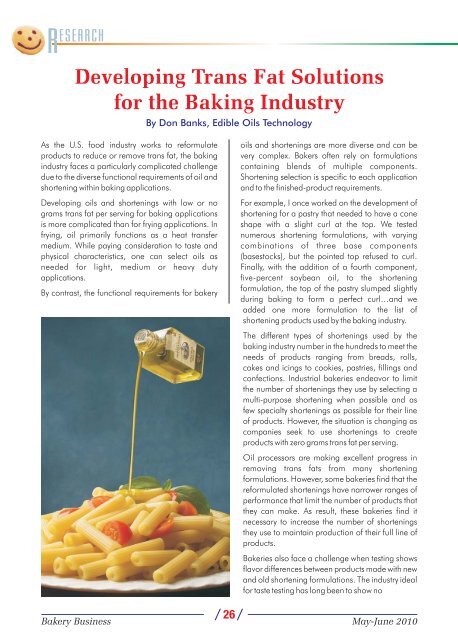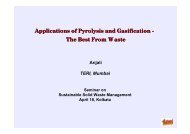business - new media
business - new media
business - new media
Create successful ePaper yourself
Turn your PDF publications into a flip-book with our unique Google optimized e-Paper software.
R ESEARCH<br />
Developing Trans Fat Solutions<br />
for the Baking Industry<br />
By Don Banks, Edible Oils Technology<br />
As the U.S. food industry works to reformulate<br />
products to reduce or remove trans fat, the baking<br />
industry faces a particularly complicated challenge<br />
due to the diverse functional requirements of oil and<br />
shortening within baking applications.<br />
Developing oils and shortenings with low or no<br />
grams trans fat per serving for baking applications<br />
is more complicated than for frying applications. In<br />
frying, oil primarily functions as a heat transfer<br />
medium. While paying consideration to taste and<br />
physical characteristics, one can select oils as<br />
needed for light, medium or heavy duty<br />
applications.<br />
By contrast, the functional requirements for bakery<br />
oils and shortenings are more diverse and can be<br />
very complex. Bakers often rely on formulations<br />
containing blends of multiple components.<br />
Shortening selection is specific to each application<br />
and to the finished-product requirements.<br />
For example, I once worked on the development of<br />
shortening for a pastry that needed to have a cone<br />
shape with a slight curl at the top. We tested<br />
numerous shortening formulations, with varying<br />
combinations of three base components<br />
(basestocks), but the pointed top refused to curl.<br />
Finally, with the addition of a fourth component,<br />
five-percent soybean oil, to the shortening<br />
formulation, the top of the pastry slumped slightly<br />
during baking to form a perfect curl…and we<br />
added one more formulation to the list of<br />
shortening products used by the baking industry.<br />
The different types of shortenings used by the<br />
baking industry number in the hundreds to meet the<br />
needs of products ranging from breads, rolls,<br />
cakes and icings to cookies, pastries, fillings and<br />
confections. Industrial bakeries endeavor to limit<br />
the number of shortenings they use by selecting a<br />
multi-purpose shortening when possible and as<br />
few specialty shortenings as possible for their line<br />
of products. However, the situation is changing as<br />
companies seek to use shortenings to create<br />
products with zero grams trans fat per serving.<br />
Oil processors are making excellent progress in<br />
removing trans fats from many shortening<br />
formulations. However, some bakeries find that the<br />
reformulated shortenings have narrower ranges of<br />
performance that limit the number of products that<br />
they can make. As result, these bakeries find it<br />
necessary to increase the number of shortenings<br />
they use to maintain production of their full line of<br />
products.<br />
Bakeries also face a challenge when testing shows<br />
flavor differences between products made with <strong>new</strong><br />
and old shortening formulations. The industry ideal<br />
for taste testing has long been to show no<br />
26<br />
Bakery Business May-June 2010

















